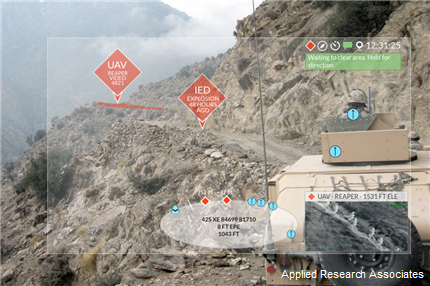DARPA-funded augmented reality technology moves to commercial sector
Heads-up display software could appeal to gamers, military trainers.

Developed over the course of six years in a secretive Defense Advanced Research Projects Agency program, the Applied Research Associates’ (ARA) augmented reality software has made significant headway in the realm of heads-up displays.
Heads-up displays, otherwise known as HUDs, have been commonly used in video games and vehicle cockpits to provide enhanced situational awareness and information without requiring the user to look down at instruments.
In order to provide the same capabilities for ground troops, DARPA initiated the Urban Leader Tactical Response, Awareness & Visualization (ULTRA-VIS) program. The six-year old program sought to provide full-color graphical iconography that could be overlaid on top of what was being seen by the soldier, allowing them to visualize the location of aircraft, hazards, and vehicles even when out of line-of-sight. The system was also designed to provide soldiers with imagery, navigation routes, and alerts, according to DARPA.
ARA became the prime contractor of the program, ultimately producing the ARC 4 augmented reality software.
The software can be integrated with different wearable displays from BAE Systems, Lumus, Vuzix, and Exelis. The ARC 4 has been prominently featured on BAE Systems’ Q-Warrior display, which was developed as the hardware portion of the ULTRA-VIS program. The Q-Warrior system underwent field testing in February of this year.
Besides being easily integrated on a variety of display hardware, the ARC 4 provides head tracking algorithms to track user position and orientation and can communicate icons, images, and messages to other users to enable non-verbal and non-line-of-sight coordination, according to an ARA press release. The heads-up visualization user interface is able to convey real-time, low-latency geo-registered information to users.
ARA envisions that the technology could be used in both commercial and military applications. For instance, consumers could do their social networking without looking down at their phones, and first responders could coordinate and assess statuses more effectively. The technology could also be boon for augmented reality games, allowing players to experience virtual enemies and avatars in real environments.
For military users, the HUDs could be used to project virtual avatars in customized decision-making exercises in on-the-move, outdoor environments. In tactical operations, the display could provide important intelligence, command, and control information that would allow users to coordinate as a team.
The ARC 4 will likely compete with commercial technologies such as Google Glass – the Air Force recently began testing Google technology for use by pararescue jumpers, who could potentially use the glasses to monitor casualty vital signs through an app.
The ARC 4 software has an advantage over Google Glass, however. “ARC 4 does more than present conventional communications and directional information (e.g., messages, tweets, maps, pictures) in a heads-up fashion,” according to ARA. “ARC4 is transforming your view of the world with digital tags that persist as if painted on physical objects.”




